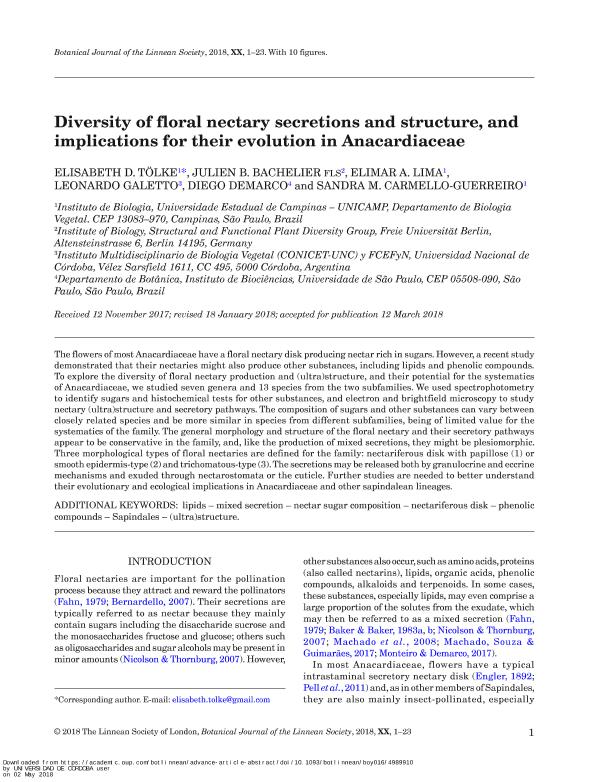Mostrar el registro sencillo del ítem
dc.contributor.author
Tölke, Elisabeth D.
dc.contributor.author
Bachelier, Julian B.
dc.contributor.author
Lima, Elimar A.
dc.contributor.author
Galetto, Leonardo

dc.contributor.author
Demarco, Diego
dc.contributor.author
Carmello Guerreiro, Sandra María

dc.date.available
2019-10-21T13:19:40Z
dc.date.issued
2018-05
dc.identifier.citation
Tölke, Elisabeth D.; Bachelier, Julian B.; Lima, Elimar A.; Galetto, Leonardo; Demarco, Diego; et al.; Diversity of floral nectary secretions and structure, and implications for their evolution in Anacardiaceae; Wiley Blackwell Publishing, Inc; Botanical Journal of The Linnean Society; 187; 2; 5-2018; 209-231
dc.identifier.issn
0024-4074
dc.identifier.uri
http://hdl.handle.net/11336/86553
dc.description.abstract
The flowers of most Anacardiaceae have a floral nectary disk producing nectar rich in sugars. However, a recent study demonstrated that their nectaries might also produce other substances, including lipids and phenolic compounds. To explore the diversity of floral nectary production and (ultra)structure, and their potential for the systematics of Anacardiaceae, we studied seven genera and 13 species from the two subfamilies. We used spectrophotometry to identify sugars and histochemical tests for other substances, and electron and brightfield microscopy to study nectary (ultra)structure and secretory pathways. The composition of sugars and other substances can vary between closely related species and be more similar in species from different subfamilies, being of limited value for the systematics of the family. The general morphology and structure of the floral nectary and their secretory pathways appear to be conservative in the family, and, like the production of mixed secretions, they might be plesiomorphic. Three morphological types of floral nectaries are defined for the family: nectariferous disk with papillose (1) or smooth epidermis-type (2) and trichomatous-type (3). The secretions may be released both by granulocrine and eccrine mechanisms and exuded through nectarostomata or the cuticle. Further studies are needed to better understand their evolutionary and ecological implications in Anacardiaceae and other sapindalean lineages.
dc.format
application/pdf
dc.language.iso
eng
dc.publisher
Wiley Blackwell Publishing, Inc

dc.rights
info:eu-repo/semantics/openAccess
dc.rights.uri
https://creativecommons.org/licenses/by-nc-sa/2.5/ar/
dc.subject
(ULTRA)STRUCTURE
dc.subject
LIPIDS
dc.subject
MIXED SECRETION
dc.subject
NECTAR SUGAR COMPOSITION
dc.subject
NECTARIFEROUS DISK
dc.subject
PHENOLIC COMPOUNDS
dc.subject
SAPINDALES
dc.subject.classification
Ciencias de las Plantas, Botánica

dc.subject.classification
Ciencias Biológicas

dc.subject.classification
CIENCIAS NATURALES Y EXACTAS

dc.title
Diversity of floral nectary secretions and structure, and implications for their evolution in Anacardiaceae
dc.type
info:eu-repo/semantics/article
dc.type
info:ar-repo/semantics/artículo
dc.type
info:eu-repo/semantics/publishedVersion
dc.date.updated
2019-10-18T18:08:50Z
dc.identifier.eissn
1095-8339
dc.journal.volume
187
dc.journal.number
2
dc.journal.pagination
209-231
dc.journal.pais
Reino Unido

dc.journal.ciudad
Londres
dc.description.fil
Fil: Tölke, Elisabeth D.. Universidade Estadual de Campinas; Brasil
dc.description.fil
Fil: Bachelier, Julian B.. Universität zu Berlin; Alemania
dc.description.fil
Fil: Lima, Elimar A.. Universidade Estadual de Campinas; Brasil
dc.description.fil
Fil: Galetto, Leonardo. Consejo Nacional de Investigaciones Científicas y Técnicas. Centro Científico Tecnológico Conicet - Córdoba. Instituto Multidisciplinario de Biología Vegetal. Universidad Nacional de Córdoba. Facultad de Ciencias Exactas Físicas y Naturales. Instituto Multidisciplinario de Biología Vegetal; Argentina
dc.description.fil
Fil: Demarco, Diego. Universidade de Sao Paulo; Brasil
dc.description.fil
Fil: Carmello Guerreiro, Sandra María. Universidade Estadual de Campinas; Brasil
dc.journal.title
Botanical Journal of The Linnean Society

dc.relation.alternativeid
info:eu-repo/semantics/altIdentifier/doi/http://dx.doi.org/10.1093/botlinnean/boy016
dc.relation.alternativeid
info:eu-repo/semantics/altIdentifier/url/https://academic.oup.com/botlinnean/article-abstract/187/2/209/4989910
Archivos asociados
